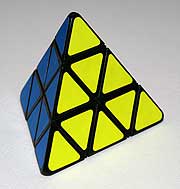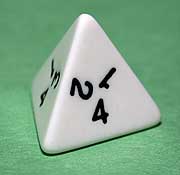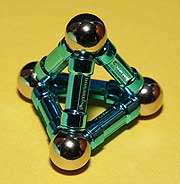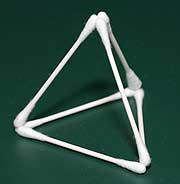|
The regular tetrahedron
|
The regular tetrahedron is the most basic of all polyhedra. It has 4 faces, which are all equilateral triangles. It has 6 edges and 4 vertices. As a general form, the tetrahedron is the ony polyhedron with 4 faces, it is the only polyhedron with 6 edges, and it is the only polyhedron with 4 vertices, and no polyhedron can be built with fewer faces, with fewer edges, or with  fewer vertices; that means that any effort to build any nomenclature of polyhedra starting from the smallest number of faces, of edges or of vertices always starts with a tetrahedron. Following that natural order, the regular tetrahedron is therefore the first polyhedron that I write about. fewer vertices; that means that any effort to build any nomenclature of polyhedra starting from the smallest number of faces, of edges or of vertices always starts with a tetrahedron. Following that natural order, the regular tetrahedron is therefore the first polyhedron that I write about.
The regular tetrahedron is part of the family of 5 platonic solids, which are the most regular polyhedra. It is also part of the family of 8 convex  deltahedra (because it is convex and all its faces are equilateral triangles), and it is the first member of the infinite family of pyramids (one of the vertices shares identical edges with all the other vertices, which are arranged as a regular polygon). deltahedra (because it is convex and all its faces are equilateral triangles), and it is the first member of the infinite family of pyramids (one of the vertices shares identical edges with all the other vertices, which are arranged as a regular polygon).
The tetrahedron's simplicity gives it a few other unusual or unique properties. It is the only convex polyhedron in which the straight line between any two vertices is always an edge (mathematically, that means that  the tetrahedron has no polyhedron diagonals, just like a triangle in two dimensions). If you join the centers of the faces that share a common edge (mathematically, that's called creating the dual polyhedron), you get another tetrahedron, and the faces of the dual have the same shape as the faces of the original; the tetrahedron is therefore called self-dual. the tetrahedron has no polyhedron diagonals, just like a triangle in two dimensions). If you join the centers of the faces that share a common edge (mathematically, that's called creating the dual polyhedron), you get another tetrahedron, and the faces of the dual have the same shape as the faces of the original; the tetrahedron is therefore called self-dual.
The regular tetrahedron defines two sets of symmetry axes: one set of 4 3-fold axes that join each vertex to its opposite face, and one set of 3 2-fold axis that join the middle of opposite edges.
Tetrahedra occur in nature, and especially in chemistry: the 4 hydrogen atoms of a methane molecule are exactly located at the vertices of a  tetrahedron. The same is true for the hydrogen atoms in the ammonium ion, and for the atoms surrounding the central carbon in tetrafluoromethane, tetrachloromethane, tetrabromomethane and tetraiodomethane. The same molecular geometry occurs in perchlorate, sulfate and phosphate ions. Finally, the atoms in diamond and in silicon crystals follow a tetrahedral geometry. tetrahedron. The same is true for the hydrogen atoms in the ammonium ion, and for the atoms surrounding the central carbon in tetrafluoromethane, tetrachloromethane, tetrabromomethane and tetraiodomethane. The same molecular geometry occurs in perchlorate, sulfate and phosphate ions. Finally, the atoms in diamond and in silicon crystals follow a tetrahedral geometry.
The regular tetrahedron is the shape that is used to build 4-sided dice.
The regular tetrahedron can be built with various construction toys, like Zome, Magnetix (see article), Googolplex and Polymorf.
The following table lists the various dimensions in a regular tetrahedron, assuming that the edge length is 1:
| single edge length | 1 | | total edge length | 6 | | face inradius | 0.288 | | face circumradius | 0.577 | | polyhedron inradius | 0.204 | | polyhedron midradius | 0.354 | | polyhedron circumradius | 0.612 | | single face area | 0.433 | | total face area | 1.732 | | volume | 0.118 |
The following table is the reciprocal of the previous one, it lists the edge length that yields a value of 1 fo the different measurements in a regular tetrahedron:
| 1 | single edge length | | 0.167 | total edge length | | 3.464 | face inradius | | 1.732 | face circumradius | | 4.899 | polyhedron inradius | | 2.828 | polyhedron midradius | | 1.633 | polyhedron circumradius | | 1.52 | single face area | | 0.76 | total face area | | 2.04 | volume |
The following table lists various angles in a regular tetrahedron:
| angle between vertices (from center) | 109.5 degrees | | angle between edges | 60 degrees | | angle between faces | 70.5 degrees |
|
|
Home page
|
Related articles
|
Posted on May 3 2007
|